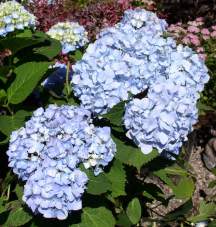Hydrangea Bigleaf Hybrids – Pruning, Winter Care and Fertilizing

Flower, plant growing in acid soil
Includes Endless Summer, Blushing Bride and Twist N Shout.
The timing of pruning is very important on this plant. They bloom on old and new wood, but some winters the flower buds will not make it. Then in late spring after any chance of late frost, remove the mulch and wait a bit to prune. New growth should come from the base and some time up the stems, remove the parts that didn’t survive the winter. A bit more pruning can be done in July to redirect the plant.
By fertilizing young shrubs you can increase both the size and the amount of flowers on the plant. Granular, liquid or stake type fertilizers can be used. Granular types should be worked into the soil around the plant at a rate of 2 pounds or 2 pints per 100 square feet of planting bed. An alternative way is to drill or punch 6″ deep holes at the drip line of the plant. Poured into these holes should be a total of 1/4 pound of fertilizer per foot of height or spread of the shrub (divided up and poured evenly between all of the holes). These holes should not be filled with more than 1/3 of the fertilizer and then they should be top filled with soil. This method of fertilization should only be done once a year, and is best done in late fall after leaf drop, or in early spring before bud break.
Liquid fertilizers (such as Miracle Gro) are mixed with water and applied the same as you would water the plant (see product for specific details). This should be done three or four times per year starting in late April and ending in mid July. Stake type fertilizers can be used following the directions on the package. With any of the above techniques a balanced mix should be used, 20-20-20 or 20-30-20 or 18-24-16. Organic fertilizers, like manure, can also be used with good results. The material should be worked into open soil at a rate of one bushel per one 6′ shrub or 100 sq. ft. of bed area.
This plant grows and develops best in acidic soil. Most of the soil, all of the rainwater and all of the ground water in southeastern Wisconsin is basic or alkaline. Therefore, for some plants to thrive, they need to have special care. Initially, the soil the plant is installed into should be amended to make it more acidic and to increase the amount of organic matter in the soil. Over time, the soils acidity should be supplemented with soil sulfur, aluminum sulfate or cotton seed meal, however, these products will not fertilize the plant. Mulch is also important to acid loving plants. A 3-4″ thickness of bark or needle mulch should surround the plant at least as far out as its drip line.
Rabbits and cold can do a great deal of damage to these hydrangeas in winter. So something that will help both is good. Tie up the plant if too broad, then encircle with a cylinder of hardware cloth 18 or 24″ high. Work the bottom into the soil and fill with straw or loosely packed leaves with a few twigs to reduce compacting. This will keep the rabbits from eating the plant, keep the plant out of the wind and reduce early growth. This protection should be installed in late November and removed in mid April. If the above protection is not possible, mulch in fall with 4″ of compost or mulch.
In areas were rabbits are not a concern, 3 stakes surrounded with burlap or landscape fabric and filled with straw or loosely packed leaves with a few twigs to reduce compacting would also work.
